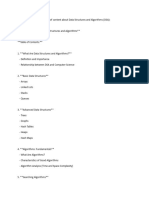0% found this document useful (0 votes)
7 views2 pagesDSA Roadmap Basic To Advanced
The document outlines a comprehensive roadmap for mastering Data Structures and Algorithms (DSA), divided into three main steps: foundational data structures, topic-wise algorithms, and other core concepts. It covers essential data structures like arrays, linked lists, trees, and graphs, along with various algorithms for searching, sorting, recursion, greedy methods, dynamic programming, and graph traversal. Additionally, it provides a learning strategy emphasizing implementation, problem-solving, and utilizing online platforms for practice.
Uploaded by
Shruti RapoluCopyright
© © All Rights Reserved
We take content rights seriously. If you suspect this is your content, claim it here.
Available Formats
Download as PDF, TXT or read online on Scribd
0% found this document useful (0 votes)
7 views2 pagesDSA Roadmap Basic To Advanced
The document outlines a comprehensive roadmap for mastering Data Structures and Algorithms (DSA), divided into three main steps: foundational data structures, topic-wise algorithms, and other core concepts. It covers essential data structures like arrays, linked lists, trees, and graphs, along with various algorithms for searching, sorting, recursion, greedy methods, dynamic programming, and graph traversal. Additionally, it provides a learning strategy emphasizing implementation, problem-solving, and utilizing online platforms for practice.
Uploaded by
Shruti RapoluCopyright
© © All Rights Reserved
We take content rights seriously. If you suspect this is your content, claim it here.
Available Formats
Download as PDF, TXT or read online on Scribd
/ 2






























































